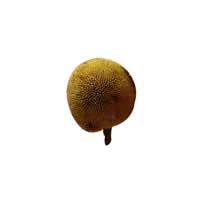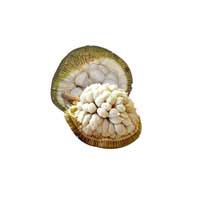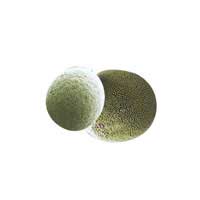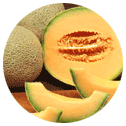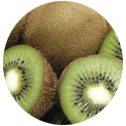 Full List of Fruits
Full List of Fruits  Marang Fruit
Marang FruitMarang Fruit
Scientific name - Artocarpus odoratissimus
Having an intimate bond with the jackfruit, cempedak and breadfruit trees, Artocarpus odoratissimus is known by several regional names such as terap, green pedalai, madang, johey oak, timadang or tarap and it is a tree type that is indigenous to Borneo, Palawan and Mindanao Island. This evergreen tree grows upto 25 metres (82 ft) tall. With little less lobed, they share the same features to that of a breadfruit and the leaves are 16-50 cm long and 11-28 cm broad. As soon as it reaches the maturity stage, majority of trees lose the leaf lobing. As already said, the appearance of the fruit will be similar to the breadfruit with some included aspects of the jackfruit. Weighing just about 1kg, they are round to oblong in shape and are 15–20 cm long with 13cm width.
As the fruit matures, it changes color from green to yellow and becomes hard and brittle. Until over-ripe, the fruit does not fall to the ground, coming to the seeds of the fruit, they can be consumed after boiling or roasting. As far as harvesting is concerned, they can be done when full size, but still firm and left to ripen until soft. Soft and broad spines act as an outer protective layer for the thick rind and its cut open when you want to open the ripe fruit. It is good to consume the fruit as it is ripe and opened; else it loses its flavor and oxidizes fast.
![]() Nutritional Value of Marang Fruit
Nutritional Value of Marang Fruit
The fruit is a rich source of energy and contains lots of carbohydrates eventually broken into glucose. Packed with protein and fat, it is also known as athlete’s fruit and are very much compatible to the banana. Moreover they are also rich in protein, fat, carbohydrates, ash, calcium, phosphorous, iron, crude fiber, retinol, beta-carotene, niacin, thiamine, riboflavin, Vitamin A and C.
| Nutritions | value |
| Water | 65.7-84.2 grams |
| Protein | 0.8-1.7 grams |
| Fat | 2-3 grams |
| Carbohydrate | 32.4 grams |
| Calcium | 17 mg |
| Phosphorus | 35 mg |
| Iron | 2.1 mg |
| Vitamin C | 30 mg |
![]() Health benefits of Marang Fruit
Health benefits of Marang Fruit
The health benefits of marang fruit are numerous and it has been used for centuries to treat various illnesses. It is a rich source of dietary fiber, vitamins, minerals, and antioxidants. It is also low in calories and fat, making it a great snack for those who want to lose weight.
One of the most important health benefits of marang fruit is its high antioxidant content. Antioxidants help to reduce the damage caused by free radicals, which are unstable molecules that can damage cells and contribute to the development of chronic diseases like cancer and heart disease. Marang fruit is high in Vitamin C, which is an antioxidant that helps to protect the body from damage caused by free radicals. It also contains carotenoids and flavonoids, both of which are powerful antioxidants.
Marang fruit is also a good source of dietary fiber. Dietary fiber is important for maintaining a healthy digestive system, as it helps to regulate the absorption of food in the stomach and intestines and can help prevent constipation. Fiber can also help lower cholesterol levels and reduce the risk of heart disease.
In addition, marang fruit is a good source of vitamins and minerals. It is high in Vitamin B6, which is essential for healthy skin, hair, and nails. It is also a good source of Vitamin A, which helps to improve vision, and Vitamin E, which helps to protect the skin from damage caused by the sun. Marang fruit is also a good source of Potassium, which helps to control blood pressure.
Marang fruit can be eaten fresh, dried, or made into a juice. It can also be used to make jams and jellies. Marang fruit is a healthy addition to any diet, as it contains numerous vitamins, minerals, and antioxidants that can help to improve overall health.
To cultivate marang fruit, it is important to select a suitable location. The tree requires full sun and well-drained soil to thrive. The soil should be slightly acidic and the tree should be provided with adequate water during the flowering and fruiting season.
Pruning of the tree is important to help the tree develop strong branches and encourage fruiting. The tree should be pruned annually, and dead, diseased, and damaged branches should be removed.
Marang fruit is also susceptible to several pests and diseases. Regular monitoring of the tree is important to identify any pests or diseases and take necessary measures to control them.
In conclusion, the marang fruit is a delicious tropical fruit that is native to Southeast Asia and the southern parts of China. It is a rich source of vitamins and minerals and contains high levels of beta-carotene. To cultivate marang fruit, it is important to select a suitable location, provide adequate water and sun, and prune the tree annually. Regular monitoring of the tree is also important to detect and control any pests or diseases.
Marang is a seasonal fruit, usually ripening from March to May. During this time, the fruit is highly sought after and sold in markets throughout the region. The fruit is usually picked when it is ripe and consumed fresh. It can also be used to make jams, jellies, or other sweet treats. Additionally, the leaves of the Marang tree are sometimes used to wrap foods, adding flavor and keeping the food fresh.
The Marang fruit is a good source of several vitamins and minerals, including vitamin C, vitamin A, folate, and potassium. It also contains a good amount of dietary fiber, which helps to keep the digestive system healthy. The fruit is also known for its anti-inflammatory and antioxidant properties, which may help reduce the risk of certain diseases.
In addition to its culinary uses, the Marang fruit is also used in traditional medicine. In some cultures, the leaves and bark of the tree are used to treat skin conditions and other ailments. The fruit itself is sometimes used to treat diarrhea and other digestive issues. The juice of the fruit has also been used as an antiseptic and to reduce inflammation.
The Marang fruit is an important part of the culture and cuisine of many Southeast Asian countries. It is highly sought-after during its peak season and is used in a variety of dishes and desserts. Its nutritional content and medicinal properties also make it a beneficial addition to any diet.
The harvesting of marang fruit is a labor-intensive process that involves handpicking the ripe fruits from the tree. It is typically done during the rainy season when the fruits are at their peak of ripeness. The harvesting process begins by shaking the tree to loosen the fruits. The fruits should be picked when they are bright yellow and still firm.
Once the fruits are harvested, they should be washed, peeled, and sliced in order to remove the seeds. The seeds can then be dried in the sun for a few days before being stored for later use. The flesh of the fruit can be eaten fresh or cooked in various dishes.
Marang fruits are also used for making jams, jellies, syrups, and other sweet treats. The leaves can be cut and used as a herbal tea, which is said to have a calming effect. The bark of the tree is also used to make rope, cloth, and fuel.
In order to ensure a good yield of marang fruits, the trees must be well cared for. This includes regular pruning, fertilizing, and pest control. It is also important to water the trees regularly in order to keep the soil moist.
Marang fruits are a nutritious and delicious snack that is enjoyed by people all over the world. The harvesting process is labor-intensive, but the end result is worth the effort. With proper care, these trees can yield an abundance of fruits that can be enjoyed by the entire family.











